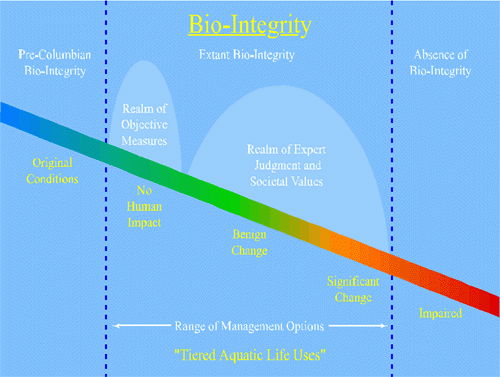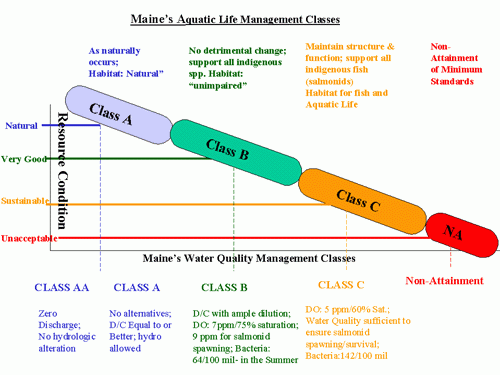Setting Goals for Desired Ecological Outcomes in Maine
In 1983, the Maine Department of Environmental Protection (DEP) initiated a statewide biomonitoring program, and by 1986, a revised water quality classification law had been passed that better accommodated the use of biological information. The three major standards in this water quality classification law are the condition of the aquatic community, levels of dissolved oxygen, and numbers of bacteria. Four levels of use have been established, from Class AA through Class C. The condition of the aquatic community that is required to be maintained at each of the four levels of use has been specifically described. The means to achieve the standards, however, is flexible and will depend upon site-specific factors. This classification system recognizes the need to have waters of different quality, from pristine recreation-oriented waters to waters of lesser quality for economic and social needs.
The 1986 revision in water quality classifications was not designed to force changes in existing water quality levels, but to improve DEP's ability to monitor and manage the state's rivers and streams. Under the previous law, a single aquatic life standard applied across the board: "Discharges shall cause no harm to aquatic life." This standard applied to the highest quality waters, Class A, as well as to the lowest quality waters, Class C. This single standard did not provide a realistic acknowledgment of the impacts of the allowable existing uses. The stage was set for potential legal battles over how the standard would be interpreted. Because there was no codified definition of the meaning of "harm," managers and stakeholders had to rely exclusively on the judgement of DEP's technical staff and their ability to convincingly document and argue their conclusions. Because the baseline against which conditions were compared, as well as the means to determine attainment, consisted of the opinions of DEP staff, the public and regulated community were denied full participation in setting management goals and agreeing on the means for assessing attainment of these goals. Many dischargers had conducted studies to demonstrate that their pollution abatement efforts had resulted in improved water quality, but because there were no standardized assessment methods, these studies were often suspected of being biased. In addition, enforcing such a restrictive aquatic life standard ("no harm") across all four classes of waters wasn't really possible. For example, plenty of waters were clearly attaining the minimum chemical and physical standards for Class C, but they were unable to meet the "no harm to aquatic life" criterion. This disconnect among the chemical, physical, and biological standards prevented logical and equitable resource management.
Biological Standards for Maine's Classes of Water Quality for Rivers and Streams
| Class | Management Perspective | Biological Standard |
|---|---|---|
| AA | High-quality water for preservation of recreational and ecological interests. No discharges of any kind, no impoundment. | Habitat natural and free flowing. Aquatic life as naturally occurs. |
| A | High-quality water with limited human interference. Impoundment allowed. Discharges must be of equal or better quality than receiving water. | Habitat natural. Aquatic life as naturally occurs. |
| B | Good quality water. Discharges of well-treated effluents with ample dilution permitted. | Habitat unimpaired. Ambient water quality sufficient to support life stages of all indigenous species. Only non- detrimental changes in community composition allowed. |
| C | Lowest quality water. Fishable and swimmable. | Ambient water quality sufficient to support life stages of all indigenous fish species. Change in community composition may occur, but structure and function of community must be maintained. |
The illustration reflects Maine's approach that biological integrity exists across a continuum from complete absence of human influence to substantial impairment. Standards that simply state "no impairment" or "no change from reference conditions" don't allow any room for varying management options. If the "reference conditions" are restricted to areas exhibiting no human impact, then the "no change" criterion is extremely restrictive. The most benign of municipal effluents or agricultural practices will cause a readily measurable change in the biota. On the other hand, if reference conditions are defined in terms of "least impacted" or "best attaining" sites, then it is possible, in areas of substantial human impact, to have the highest management goal be linked to significant adverse changes.


The tiered aquatic life use designations that are now in place in Maine allow for management options ranging from those that require the waterbody to be essentially pristine down to maintenance of minimally acceptable conditions. For instance, discharges into Class C waters are allowed to cause some changes to aquatic life, provided that the water quality continues to support all indigenous species of fish (defined as salmonid species) and the biological structure and function of the community is maintained. Regulators have a practical and direct means of defining and assessing biological integrity. This introduces some flexibility for the dischargers, who can implement control measures of their choice that will allow the impact standard to be met. (Of course, compliance with chemical-specific permit limits is still required.) The establishment of commonly accepted goals and standardized bioassessment has allowed the regulated community to demonstrate to the public, lawmakers, environmental agencies, and environmental advocacy groups that their investment in pollution abatement has been sufficient and that further controls need be imposed only where problems can be demonstrated. The public is able to be presented with an honest picture of the extent of the ecological consequences of decisions, in relation to what would exist under natural conditions.
Lesson Learned
The shift toward use of impact or outcome standards (versus performance standards) can lessen the technical and legal burden on the regulator to identify, establish, and defend measures to control each pollutant and each source, and allow for more equitable management of both point and nonpoint sources. Tiered aquatic life use designations were a key feature in the implementation of outcome-based biological standards in Maine.
Additional Information
Contact Susan Davies ([email protected]) at Maine DEP at 207-287-7778.
Maine website
References
Courtemanch, D.L., S.P. Davies, and E.B. Laverty, 1989. Incorporation of biological information in water quality planning, Environmental Management, Vol. 13, No. 1, pp. 35-41.
Courtemanch, D.L, 1995. Merging the science of biological monitoring with water resource management policy: criteria development, pp. 315-325 (Chapter 20). In W.S. Davis and T. Simon (eds.). Biological Assessment and Criteria: Tools for Water Resource Planning and Decision Making. Lewis Publishers, Boca Raton, FL.
